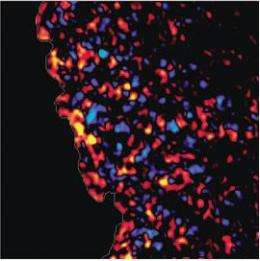Cooperative forces boost collective mobility of cells

An article by Dr. Xavier Trepat, senior researcher of the Cellular and respiratory biomechanics group at the University of Barcelona, Spain, contributes for the first time an experimental answer to the question of how cells move during biological processes as diverse as the development, metastasis, or regeneration of tissues.
The work, entitled “Physical forces during collective cell migration”, has just been published by Nature Physics and addresses the issue of collective mobility of cells, that is to say, how cells are moved within tissues, and what is the prevalent form of movement inside living organisms.
"Research into collective cell mobility is very active due to the direct implications it has on fields such as embryologic development, organ regeneration, and cancer. For example, if we could find a way to control cell mobility during metastasis, cancer would be a curable disease in the majority of cases," says Xavier Trepat, who is also researcher in the Department of Physiological Sciences at the University of Barcelona, and in the Networking Biomedical Research Centre for respiratory diseases (CIBER).
Up until now, scientists had proposed various mechanisms to explain collective cell migration. One hypothesis for example, suggests that the cells move collectively due to the existence of “leader” cells, which stretch out in the rest of the group, like a train pulls carriages behind it. Another hypothesis suggests that each cell moves independently to those around it, like cars on the motorway during a traffic jam, or like soldiers in a military parade. “We have rejected both these possibilities,” says Trepat.
According to his research, collective cell mobility is the result of a cooperative process in which each cell contributes to the movement of the group, stretching to those around it. “It is a mechanism similar to a tug-of-war game, in which two teams pull a rope by its extremes and the team that pulls the hardest wins. During the game, each player generates force and transmits it to the rope, so that the tension in the rope is the sum of the forces generated by each member of the team. Cells do the same. Each cell generates force to stretch to its neighbours in the direction of the movement» explains the researcher.
Source: University of Barcelona (news : web)















